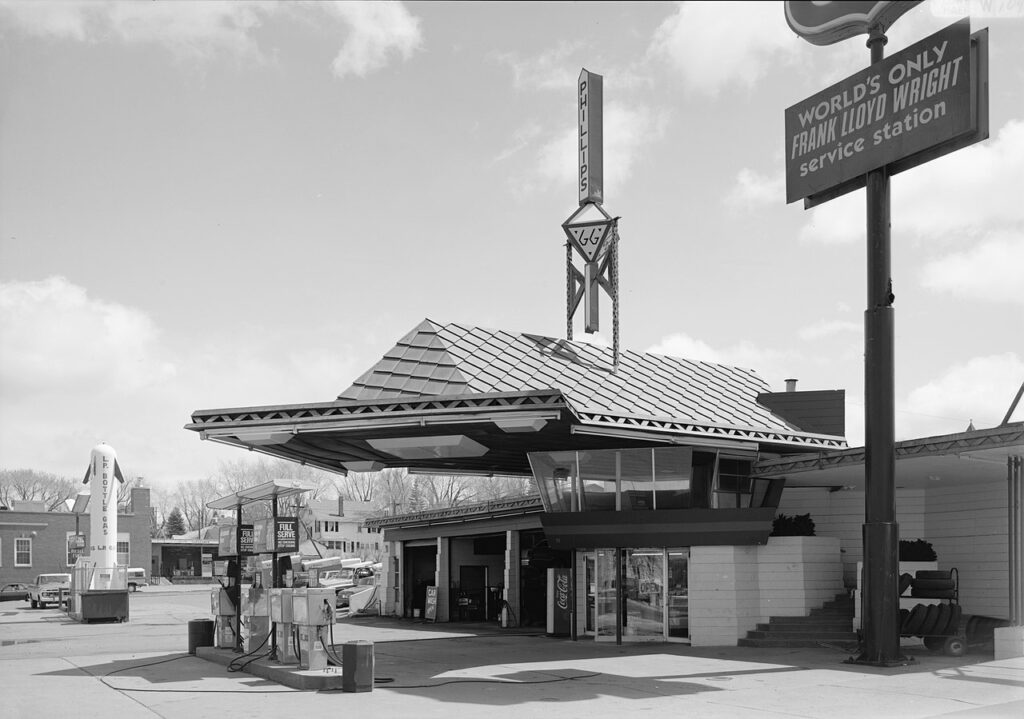Why Frank Lloyd Wright Designed a Gas Station in Minnesota (1958)

In the small town of Cloquet, Minnesota stands a piece of urban utopia. It takes the surprising form of a gas station, albeit one designed by no less a visionary of American architecture than Frank Lloyd Wright. He originally conceived it as an element of Broadacre City, a form of mechanized rural settlement intended as a Jeffersonian democracy-inspired rebuke against what Wright saw as the evils of the overgrown twentieth century city, first publicly presented in his 1932 book The Disappearing City. “That’s an aspirational title,” says architectural historian Richard Kronick in the Twin Cities PBS video above. “He thought that cities should go away.”
Cities didn’t go away, and Broadacre City remained speculative, though Wright did pursue every opportunity he could identify to bring it closer to reality. “In 1952, Ray and Emma Lindholm commissioned Frank Lloyd Wright to build them a home on the south side of Cloquet,” writes photographer Susan Tregoning.
When Wright “discovered that Mr. Lindholm was in the petroleum business, he mentioned that he was quite interested in gas station design.” When Lindholm decided to rebuild a Phillips 66 station a few years later, he accepted Wright’s design proposal, calling it “an experiment to see if a little beauty couldn’t be incorporated in something as commonplace as a service station” — though Wright himself, characteristically, wasn’t thinking in quite such humble terms.
Wright’s R. W. Lindholm Service Station incorporates a cantilevered upper-level “customer lounge,” and the idea, as Kronick puts it, “was that customers would sit up here and while their time away waiting for their cars to be repaired,” and no doubt “discuss the issues of the day.” In Wright’s mind, “this little room is where the details of democracy would be worked out.” As with Southdale Center, Victor Gruen’s pioneering shopping mall that had opened two years earlier in Minneapolis, two hours south of Cloquet, the community aspect of the design never came to fruition: though its windows offer a distinctively American (or to use Wright’s language, Usonian) vista, the customer lounge has a bare, disused look in the pictures visitors take today.

Image by Library of Congress, via Wikimedia Commons
There are many such visitors, who arrive from not just all around the country but all around the world. But when it was last sold in 2018, the buyer it found was relatively local: Minnesota-born Andrew Volna, owner of such Minneapolis operations as vinyl-record manufacturer Noiseland Industries and the once-abandoned, now-renovated Hollywood Theater. “Wright saw the station as a cultural center, somewhere to meet a friend, get your car fixed, and have a cup of coffee while you waited,” writes Tregoning, though he never did make it back out to the finished building before he died in 1959. These sixty-odd years later, perhaps Volna will be the one to turn this unlikely architectural hot spot into an even less likely social one as well.
Related content:
Frank Lloyd Wright Designs an Urban Utopia: See His Hand-Drawn Sketches of Broadacre City (1932)
How Frank Lloyd Wright’s Son Invented Lincoln Logs, “America’s National Toy” (1916)
The Modernist Gas Stations of Frank Lloyd Wright and Mies van der Rohe
When Frank Lloyd Wright Designed a Doghouse, His Smallest Architectural Creation (1956)
Based in Seoul, Colin Marshall writes and broadcasts on cities, language, and culture. His projects include the Substack newsletter Books on Cities, the book The Stateless City: a Walk through 21st-Century Los Angeles and the video series The City in Cinema. Follow him on Twitter at @colinmarshall or on Facebook.


